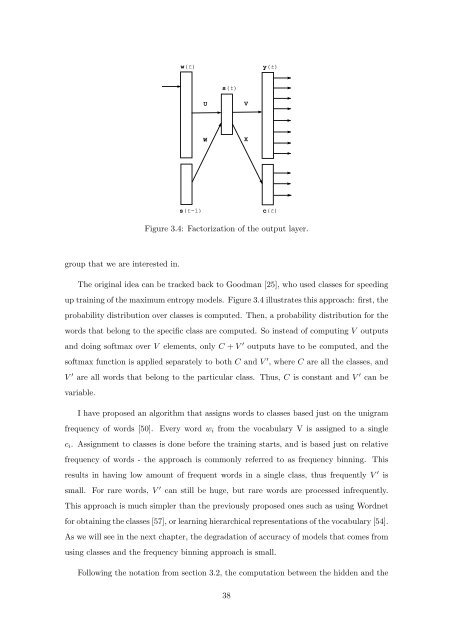Statistical Language Models based on Neural Networks - Faculty of ...
Statistical Language Models based on Neural Networks - Faculty of ...
Statistical Language Models based on Neural Networks - Faculty of ...
Create successful ePaper yourself
Turn your PDF publications into a flip-book with our unique Google optimized e-Paper software.
group that we are interested in.<br />
w(t)<br />
s(t-1)<br />
U<br />
s(t)<br />
V<br />
W X<br />
y(t)<br />
c(t)<br />
Figure 3.4: Factorizati<strong>on</strong> <strong>of</strong> the output layer.<br />
The original idea can be tracked back to Goodman [25], who used classes for speeding<br />
up training <strong>of</strong> the maximum entropy models. Figure 3.4 illustrates this approach: first, the<br />
probability distributi<strong>on</strong> over classes is computed. Then, a probability distributi<strong>on</strong> for the<br />
words that bel<strong>on</strong>g to the specific class are computed. So instead <strong>of</strong> computing V outputs<br />
and doing s<strong>of</strong>tmax over V elements, <strong>on</strong>ly C + V ′ outputs have to be computed, and the<br />
s<strong>of</strong>tmax functi<strong>on</strong> is applied separately to both C and V ′ , where C are all the classes, and<br />
V ′ are all words that bel<strong>on</strong>g to the particular class. Thus, C is c<strong>on</strong>stant and V ′ can be<br />
variable.<br />
I have proposed an algorithm that assigns words to classes <str<strong>on</strong>g>based</str<strong>on</strong>g> just <strong>on</strong> the unigram<br />
frequency <strong>of</strong> words [50]. Every word wi from the vocabulary V is assigned to a single<br />
ci. Assignment to classes is d<strong>on</strong>e before the training starts, and is <str<strong>on</strong>g>based</str<strong>on</strong>g> just <strong>on</strong> relative<br />
frequency <strong>of</strong> words - the approach is comm<strong>on</strong>ly referred to as frequency binning. This<br />
results in having low amount <strong>of</strong> frequent words in a single class, thus frequently V ′ is<br />
small. For rare words, V ′ can still be huge, but rare words are processed infrequently.<br />
This approach is much simpler than the previously proposed <strong>on</strong>es such as using Wordnet<br />
for obtaining the classes [57], or learning hierarchical representati<strong>on</strong>s <strong>of</strong> the vocabulary [54].<br />
As we will see in the next chapter, the degradati<strong>on</strong> <strong>of</strong> accuracy <strong>of</strong> models that comes from<br />
using classes and the frequency binning approach is small.<br />
Following the notati<strong>on</strong> from secti<strong>on</strong> 3.2, the computati<strong>on</strong> between the hidden and the<br />
38







